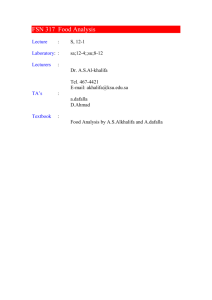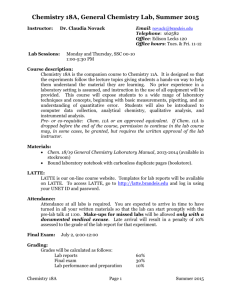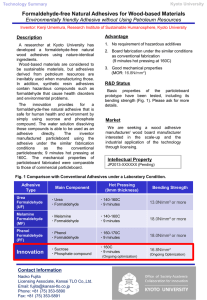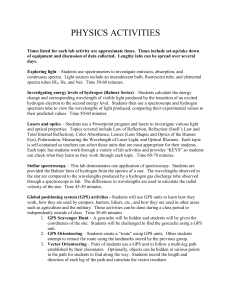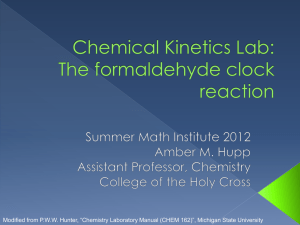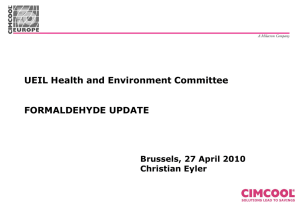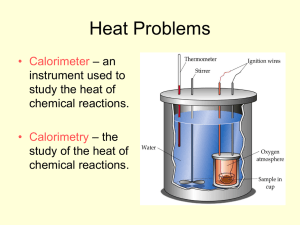Supporting Information
advertisement
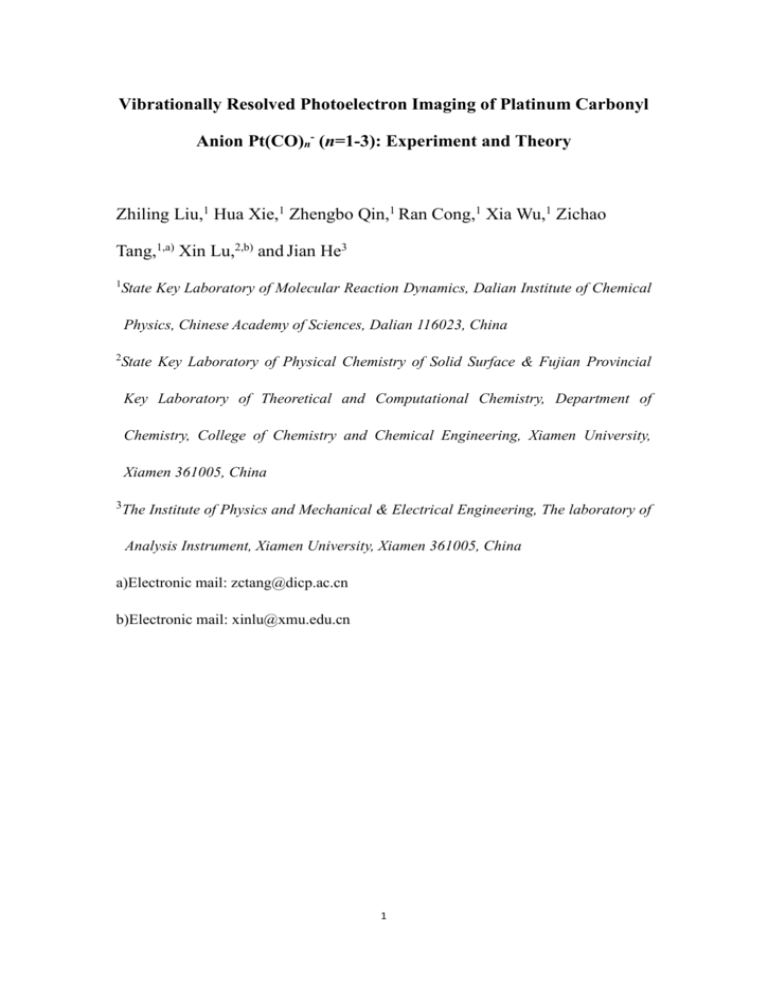
Vibrationally Resolved Photoelectron Imaging of Platinum Carbonyl Anion Pt(CO)n- (n=1-3): Experiment and Theory Zhiling Liu,1 Hua Xie,1 Zhengbo Qin,1 Ran Cong,1 Xia Wu,1 Zichao Tang,1,a) Xin Lu,2,b) and Jian He3 1 State Key Laboratory of Molecular Reaction Dynamics, Dalian Institute of Chemical Physics, Chinese Academy of Sciences, Dalian 116023, China 2 State Key Laboratory of Physical Chemistry of Solid Surface & Fujian Provincial Key Laboratory of Theoretical and Computational Chemistry, Department of Chemistry, College of Chemistry and Chemical Engineering, Xiamen University, Xiamen 361005, China 3 The Institute of Physics and Mechanical & Electrical Engineering, The laboratory of Analysis Instrument, Xiamen University, Xiamen 361005, China a)Electronic mail: zctang@dicp.ac.cn b)Electronic mail: xinlu@xmu.edu.cn 1 The band labeled asterisk in the PES of Pt(CO)3A remarkable spot locates at the center of the photoelectron image of Pt(CO)3-, corresponding to the weak mysterious band labeled asterisk in the PES of Pt(CO)3-. The signal is near the cut-off energy (2.331eV) for our electron detector. When we systematically varied the mass gate timing to select the rising edge, middle and failing edge of the Pt(CO)3- mass peak, the signal still exists, accompanied by the increasement in the relative intensity. The feature labeled asterisk can’t be assigned based on single-photon photodetachment. The ground state of Pt(CO)3- is D3h (2A2″, D3h) with a valent electron configuration …2e″4 7a1′2 8e′4 3a2″1. Upon photodetachment, the singly occupied MO of the doublet anion is depleted and becomes the LUMO of the neutral, resulting in neutral ground state with a valent electron configuration …2e″4 7a1′2 8e′4, as shown in TABLE S4. Photodetachment on the degenerate 8e′ MO will generate the lowest triplet state (3B1, C2v, due to Jahn-Teller effect) with a valent electron configuration …9b22 2a22 4b12 14a12 15a11 5b11, which is at least 2.005 eV higher in energy than the neutral ground state (TABLE 3). In Ganteför’s PESR1, R2, the first band above ground state transition originates at about 3.4 eV, in reasonable agreement with our calculated the lowest triplet (3B1, C2v) state. Consequently, there are no excited states of Pt(CO)3 predicted to lie at the energies range from 1.3 eV to 2.331 eV. We explored several possible alternative sources of this band, according to our experimental environment. Several potential nearly mass-degenerate ion beam contaminants were taken into account, including 2 PtFeCO and HPt(CO)3 (an alcohol structure [Pt(CO)2CO-H], a formaldehyde structure [H-COPt(CO)2] and a platinum hydride structure [H-Pt(CO)3], shown in FIG. S1). The DFT calculations were carried out using the B3LYP functional with the Pt, Fe/Stuttgart+2f1g /C, O, H/aug-cc-pVTZ basis sets. The EAs and VDEs for the most stable of these contaminants are summarized in TABLE S5. Note that the EA of PtFeCO is 1.59 eV, which could be masked by other dominant peaks. However, PtFeCO could be ruled out due to the difference between the pattern of experimentally observed mass spectrum and that of PtFeCO. For masses coincident with anionic HPtCO3, the platinum hydride structure was found to be the most stable of all isomers. For anion, the formaldehyde structure (1A' ground state) was calculated to lie 0.308 eV above the platinum hydride structure, and the alcohol structure, (CO)2PtCO-H- was found to lie 2.34 eV above the platinum hydride structure. The EA of the platinum hydride structure is 2.52 eV, which is beyond our photon energy (2.331 eV). Of all three isomers, only the EA (2.17 eV) of the formaldehyde structure perfectly matches with the band, suggesting that the band nearly originating at ~2.2 eV in the PES of Pt(CO)3 may come from the detachment of HPt(CO)3- of formaldehyde structure. It may be much more extended than it appears, according to our calculated VDE (2.46 eV, as shown in TABLE S4) of the formaldehyde structure. 3 TABLE S1. Harmonic vibrational frequencies (in cm-1) and infrared intensities (in parentheses, in km/mol) for PtCO0/-1. PtCO-1 PtCO a R3. b R4. c R5. d R6. e R7. Cal. Expt. Cal. Expt. 2077 (633.9) 2065.5a/2056.8b/2052.0c 1926 (974.6) 1896.3a 579 (7.0,) 580.8b/550d/593e 539 (9.0) 405 (2.5×2) 412e 97 (75.5×2) 4 TABLE S2. Harmonic vibrational frequencies (in cm-1) and infrared intensities (in parentheses, in km/mol) for Pt(CO)20/-1. Pt(CO)2-1 Pt(CO)2 Cal. Cal. Expt. B3LYP CCSD(T) 2167 (9.0) 2171 2073 (1947.2) 2067 488 (0.1) Expt. B3LYP CCSD(T) 2173a 1937 (0.0) 1953 2053.2b/2039.8c/2057.2d 1861 (2777.6) 1875 513 504 (0.0) 529 450 (0.0) 463 496 (1.3) 496 445 (0.0) 454 407 (0.0) 414 398 (138.6) 392 382 (3.6) 374 341 (0.3) 335 367 (24.6) 361 340 (0.0) 330 351 (0.0) 345 20 (0.5) 24 55 (2.6x2) 43 a This work. b R3. c R4. d R5. 383.55c 5 1884.0b TABLE S3. Harmonic vibrational frequencies (in cm-1) and infrared intensities (in parentheses, in km/mol) for Pt(CO)30/-1. Pt(CO)3-1 Pt(CO)3 Cal. Expt. Cal. 2120 (0.0) 2119a 1953 (0.0) 2060 (1287.3×2) 2044.0b/2038.1c/2049.0d 1886 (2063.2×2) 500 (12.2×2) 485.8c 526 (40.6×2) 448 (6.1) 447.5c 463 (0.0) 431 (0.0) 444a 439 (17.0) 335 (90.0×2) 348.5c 374 (22.6 ×2) 304 (0.0) 327 (0.0×2) 259 (0.0×2) 325 (0.0) 58 (0.2×2) 62 (0.2) 50 (0.8) 58 (0.1×2) a This work. b R3. c R4. d R5. 6 Expt. 1875.8b TABLE S4. Ground states and low-lying states of Pt(CO)3- and Pt(CO)3. species symmetry final state and electronic configuration energy/eV A2″…2e″4 7a1′2 8e′4 3a2″1 0.0 A1’…2e″4 7a1′2 8e′4 1.368 Pt(CO)3- D3h 2 D3h 1 C2v 3B D3h 3 C2v 3A 2 2 2 2 1 1 1…9b2 2a2 4b1 14a1 15a1 5b1 3.373 Pt(CO)3 A2″…2e″4 7a1′1 8e′4 3a2″1 2 2 1 2 2 1 1…9b2 2a2 4b1 14a1 15a1 5b1 7 4.805 7.502 TABLE S5. Summary of calculated EAs and VDEs for possible contaminants in the Pt(CO)3PES. species Neutral ground state PtFeCO 5 H-COPt(CO)2 2 Anion ground state EA (eV) VDE(eV) 4 + Σ 1.59 1.74 1 2.17 2.46 1 2.52 2.83 1A' 1.42 1.56 A" A' H-Pt(CO)3 2A Pt(CO)2CO-H 2A' A' 1A 1 References: (R1) Ganteför, G.; Icking-Konert, G. S.; Handschuh, H.; Eberhardt, W. Int. J. Mass. Spect.Ion Proc. 1996, 159, 81. (R2) Icking-Konert, G. S.; Handschuh, H.; Ganteför, G.; Eberhardt, W. Phys. Rev. Lett. 1996, 76, 1047. (R3) Liang, B. Y.; Zhon, M. F.; Andrews, L. J. Phys. Chem. A 2000, 104, 3905. (R4) Manceron, L.; Tremblay, B.; Alikhani, M. E. J. Phys. Chem. A 2000, 104, 3750. (R5) Kuendig, E. P.; McIntosh, D.; Moskovits, M.; Ozin, G. A. J. Am. Chem. Soc. 1973, 95, 7234. (R6) Chatterjee, B.; Akin, F. A.; Jarrold, C. C.; Raghavachari, K. J. Chem. Phys. 2003, 119, 10591. (R7) Okabayashi, T.; Yamamoto, T.; Okabayashi, E. Y.; Tanimoto, M. J. Phys. Chem. A 2011, 115, 1869. 8 FIG. S1. Optimized structures of HPt(CO)30/-1 at B3LYP level. The Pt, C, O and H are shown in blue, gray, red and white, respectively. Bond lengths in Å and bond angles in degree are given above the bond, and the relative energy to the anion are given in square brackets in eV. 9 Intensity (arb. unit) 1.0 1.5 2.0 Binding energy (eV) FIG. S2. The photoelectron spectrum of Pt- at 532nm. 10

